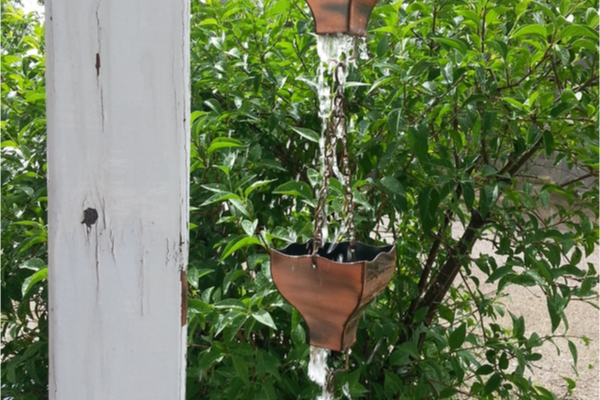Ask any homeowner: rain is one of the major challenges of protecting a home and its roof. Whether you live in a dry climate or a remarkably wet one, you’ll need to install some sort of mechanism to guide water down a drain. Some homeowners are surprised to learn that there are options for water drainage beyond the traditional gutter downspout. Recently, a more attractive and very effective alternative has become more prevalent: the rain chain.
While having recently surged in popularity here in North America, rain chains have actually been used for centuries in Asia. They originated in Japan, where they are called kusari-doi. They are still used today to keep water runoff away from the roofs of both homes and religious temples. Like many items that hail from Japan, rain chains are a perfect mix of functionality and beauty.
WHAT IS A RAIN CHAIN?
Rain chains are a decorative, functional alternative to downspouts. They beautifully move rainwater from gutters to drains or decorative water receptacles, turning a relatively unglamorous activity into a compelling, attractive water feature.
Rain chains famously hail from Japan, where they are called kusari-doi. They are often found in contemplative gardens, beautiful temples and other iconic settings. Over the past decades, these rain chains have skyrocketed in popularity here in the United States. You’ll find them not only at famed botanical gardens, but also near the porches of everyday cottages across the country.
While most homeowners go to great lengths to camouflage unsightly gutters, rain chains have been carefully designed to add character and charm to your outdoor space. You can find a rainchain in just about any color and every theme, although the copper-colored variety are definitely the most popular.
WHAT’S THE POINT OF A RAIN CHAIN?
A rain chain does two things: guide rainwater to drains and receptacles, and add beauty to a home’s exterior. When you install rain chains, you’re beautifying your home while making it more functional, too. For the most discerning homeowners, installing a rain chain is a great opportunity to protect your home without sacrificing curb appeal. These chains turn purely utilitarian gutters into true water features that add a new focal point to your home. Talk about a win-win!
HOW DO YOU INSTALL A RAIN CHAIN?
A rain chain is relatively easy to install. First, you need to know where to install it. Start by measuring the distance from any gutter or downspout you’ll be removing and the ground so you know what length of chain to buy. Then, remove the gutter. Insert a V-hook or other anchor, and attach your chain.
Then, set up your rain chain for successful draining by following these steps:
- Stake the end of your chain to the ground so it is not susceptible to high winds
- Add a basin, copper rain barrel, or rain chain receptacleto harvest and reuse rain water
- Decorate your receptacle with stones, rocks, floating plants, and whatever else you wish to complete the look!
CAN YOU USE A RAIN CHAIN WITHOUT GUTTERS?
Yes, you can use a rain chain without a gutter, but you do want your rain chain to be able to capture enough water to be able to function. Cup-style rain chains can often handle more water than link-styles, so choose according to your home’s needs and local climate.
You can quickly figure out how your roof handles rain, then use that information to inform your installation decisions. Run a hose on your roof for 10 to 15 minutes and see how water pools. If you have a sloped roof, rain will likely move toward a well-placed rain chain naturally. See where it goes, and place your rain chain accordingly. You can also attach your rain chain to gutters or downspouts! This will ensure great (and good-looking!) drainage, even if you live in a climate susceptible to constant, heavy rain.
DO RAIN CHAINS WORK IN HEAVY RAIN?
Every rain chain is different, but in general, you’ll want to attach your rain chain to a gutter or downspout for best results during very heavy rain. Don’t worry, you won’t need your gutter or downspout to go all the way to the ground. That’s what the rain chain is for. The gutter or downspout will just make sure the water is properly transported to the rain chain.
If you live in a more arid climate that experiences very little rain, such as Arizona or Southern California, you’ll probably be fine without gutters. If you’re in South Florida or another tropical, water-rich climate, using a gutter or downspout and a rain chain for the best (and most beautiful!) results.
WHAT DO RAIN CHAINS LOOK LIKE?
Most rain chains are copper or finished in a flamed-metal color for a copper-like, neutral effect. Over time, thanks to water and weather, rain chains often develop a rustic patina that’s both charming and unique. Rain chains have two main styles: cup or link. The cup style is better for climates with more rain, but they’re both effective and attractive.
CAN YOU BUILD YOUR OWN DIY RAIN CHAIN?
You can build a DIY rain chain using simple materials such as copper, recycled sheet metal, stock tanks, rocks, copper tubing, mini planters and more. We’ve even seen people use old yogurt cups and cookie cutters to make kid-friendly rain chains.
For tons of DIY inspiration, check out Pretty Handy Girl Blog. And remember, practice makes perfect. Since you’re not making purely decorative crafts (such as a mobile or garden stake), this DIY project won’t be quite so simple. You’ll need the chain to function, not just look pretty… So ensure you test your rain chains for optimal flow.
—
Photo Credit: C.N.Crumrine / Shutterstock.com
